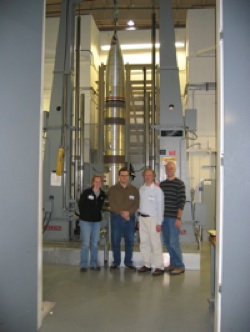SERSIO
Principal Investigator: Paul Kintner
Svalbard EISCAT Rocket Study of Ion Outflows (SERSIO) was launched with a nearly nominal trajectory from Ny-Alesund on Svalbard on January 22, 2004 at 0857UT.
The purpose of the mission was to investigate ion outflows between 600 and 800 km altitude in the polar cusp/cleft with a sounding rocket experiment and the EISCAT Svalbard radar (ESR) and the EISCAT Tromso radar. The ESR and Tromso radars were used to monitor ion outflow near the nominal rocket apogee for comparison with the sounding rocket data and to determine the launch conditions.
SERSIO integration
The sounding rocket was instrumented to measure ion drifts, electron drifts, electron and ion precipitation, convection electric fields, and plasma waves. The objectives of the experiment were to determine the physical mechanism responsible for the ionospheric outflow, the source of free energy for the outflows, and to investigate the relationship of the ion outflows to previous satellite measurements of vertical ion drifts and sounding rocket measurements of transverse ion acceleration at higher altitudes in the polar cusp/cleft.
The payload design for the SERSIO mission was based on the design of sounding rocket 40.014 flown successfully in January 2002 from Poker Flat Research Range in Fairbanks, Alaska.


